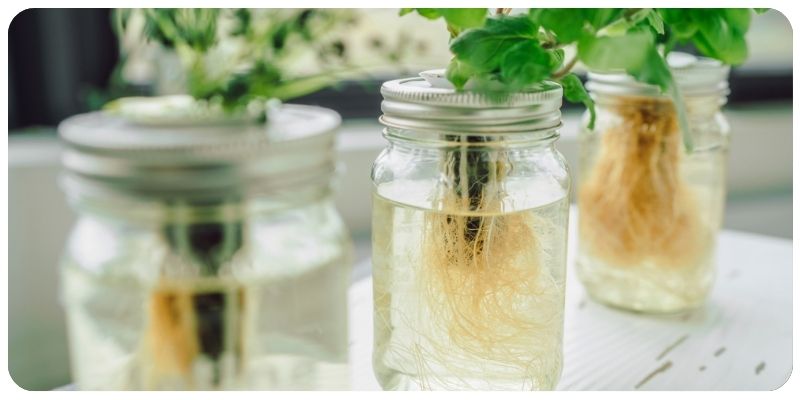
Growing Herbs in Water: A Beginner's Guide
Growing herbs in water is a simple and convenient way to enjoy fresh herbs year-round, even without access to soil or outdoor space. This method, also known as hydroponic herb gardening, is perfect for beginners and requires minimal maintenance. In this guide, we'll cover everything you need to know about growing herbs in water, from selecting the right herbs to keeping your water garden thriving.
1. Why Grow Herbs in Water?
Hydroponic gardening offers several benefits for beginners, including low maintenance, space-saving, and the ability to grow herbs indoors year-round. Some of the advantages include:
- No soil required: You don't need to deal with soil mess, and there's no need to worry about over or under watering your plants.
- Continuous harvest: Herbs grown in water can be harvested continuously, providing a fresh supply of leaves for cooking.
- Compact space: Water-grown herbs can thrive on windowsills or small kitchen counters, making them perfect for apartment dwellers or small spaces.
2. Choosing the Right Herbs for Water Growing
Not all herbs are suitable for growing in water, but many common varieties thrive in this setup. When selecting herbs, consider those that are low-maintenance and can grow quickly in water. Here are some of the best herbs for water growing:
Best Herbs to Grow in Water
- Basil: Basil is one of the easiest herbs to grow in water. It roots quickly and can provide a continuous supply of fresh leaves for cooking.
- Mint: Mint is a vigorous grower that adapts well to water-based gardening. Its refreshing leaves are perfect for tea and desserts.
- Oregano: This herb grows well in water and is a flavorful addition to soups, sauces, and Italian dishes.
- Rosemary: While rosemary may take a little longer to root in water, once established, it thrives and adds a fragrant touch to your kitchen.
- Thyme: Thyme is another herb that grows well in water, providing flavorful sprigs for garnishing dishes and making herbal teas.
3. Setting Up Your Water Herb Garden
Once you've selected your herbs, it's time to set up your water garden. Here's a step-by-step guide to starting your hydroponic herb garden:
Supplies You'll Need
- Clear glass containers: Glass jars or vases allow light to reach the roots and make it easy to monitor water levels.
- Herb cuttings: Use healthy cuttings from established herb plants. Cut about 4-6 inches from the top of the plant, ensuring there are no leaves submerged in the water.
- Filtered water: Use room-temperature, filtered water to ensure your herbs thrive without chlorine or other chemicals that may harm them.
4. Steps to Growing Herbs in Water
Follow these simple steps to get your water herb garden started:
How to Propagate Herbs in Water
- Step 1: Take cuttings from healthy herb plants. Cut just below a leaf node and remove any leaves that would be submerged in water.
- Step 2: Place the herb cuttings in clear glass containers filled with filtered water. Ensure the leaves are above the waterline while the stem is submerged.
- Step 3: Place the containers in a bright spot that gets indirect sunlight. Avoid direct sunlight, as it can cause algae to grow in the water.
- Step 4: Change the water every 5-7 days to keep it fresh and prevent bacterial growth. Rinse the roots and clean the container before adding new water.
- Step 5: Within 2-4 weeks, your herbs should start developing roots. Once the roots are well-established, your herbs are ready for regular harvests.
5. Maintaining Your Water Herb Garden
To keep your herbs healthy and growing, regular maintenance is important. Here are a few key tips for maintaining your water herb garden:
Care and Maintenance
- Prune Regularly: Regularly prune your herbs to encourage bushier growth. This will also prevent the plants from becoming too leggy.
- Avoid Overcrowding: If you're growing multiple herbs in a single container, ensure there's enough space for each plant to grow without overcrowding.
- Monitor Water Levels: Keep the water level consistent and ensure the roots are fully submerged. Top off the water as needed.
- Fertilize Sparingly: Herbs grown in water can benefit from a small dose of liquid fertilizer every 4-6 weeks, but avoid over-fertilizing, as it can lead to algae growth.
6. Harvesting Your Herbs
One of the best parts of growing herbs in water is the ability to harvest fresh leaves regularly. Harvest your herbs by pinching off the top leaves, which will encourage more growth. Always leave enough leaves on the plant to support photosynthesis and continued growth.
Conclusion
Growing herbs in water is an easy and rewarding way to have fresh herbs at your fingertips year-round. Whether you want to add flavor to your meals, create a beautiful indoor garden, or simply enjoy the convenience of hydroponic gardening, this beginner's guide will help you get started. With just a few simple steps, you can enjoy the fresh, aromatic benefits of homegrown herbs without the hassle of soil or outdoor space.